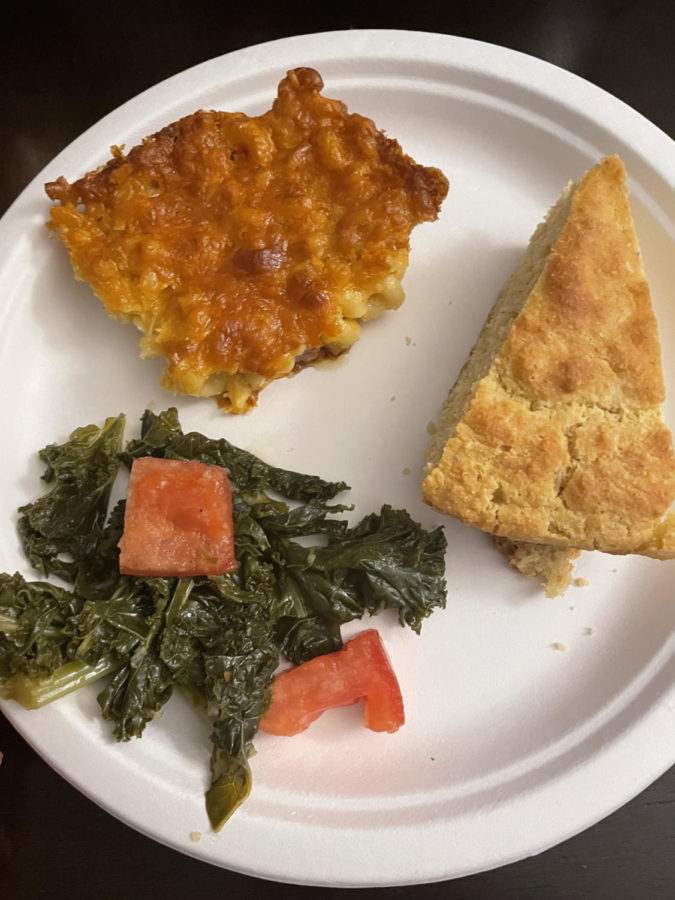The History and Cultural Impact of Baked Macaroni and Cheese
As a staple holiday dish in many American households, baked macaroni and cheese is widely represented in cookbooks and in media and television. For Black Americans, the dish also reflects a painful history.
“I think that baked mac and cheese is a staple of Black culture”, said Emani Wilson ’23.
Baked macaroni and cheese is a staple dish in traditional American families. On holidays and special events, I always saw a tray of crispy, baked mac and cheese, and everyone lined up to get themselves a piece of it.
This dish came to the United States during a painful time in American history for African Americans. People often credit President Thomas Jefferson for bringing the recipe to the Americas and introducing it to the masses through his lavish parties. However, it was on a trip to Paris where the former president and his formerly enslaved chef, James Hemings, were introduced to the dish and brought it back to Jefferson’s plantation in Virginia. At this time, Hemings was a free man, whose brother later replaced him in Jefferson’s kitchen. At a formal state dinner in the early 1800s, Hemings made “a pie called macaroni” for Jefferson’s guests.
Many decades later, and the dish now appears in countless American cookbooks, is the subject of holiday specials, and has become a staple get-together dish. Mac and cheese has also been popularized as a budget-friendly option for many people, as boxes of Kraft and Velveeta mac and cheese are widely available in local grocery stores.
My mother’s family is from Charleston, South Carolina, and they were brought to southern plantations through the transatlantic slave trade. It was believed that a part of my family was brought to South Carolina from the Caribbean, as many of my older family members had Caribbean accents. I spoke to my mother, who remembers much of our family history and spent many of her summers in South Carolina as a child.
“My grandma made mac and cheese. I viewed my grandma as the epitome of what a Black woman who provided for her family was,” she said. “She represented generations of Black women before her who just knew how to cook. The history of cooking [in our family] came from a painful time, unfortunately, but she was able to cook good meals for her family.”
Since the introduction of this dish, it has become incredibly popular, especially in the American South. It has appeared in countless cookbooks and on cooking blogs throughout the internet. The dish varies based on the preferences of the cook and the region from which the cook is from.
My family’s baked macaroni and cheese is made with heavy cream, milk, and various shredded cheeses. My Aunt Detris from Columbia, South Carolina gave me her ingredients for her macaroni and cheese recipe: “I use 1 ½ cups of macaroni pasta, 2 eggs, 1 or 1 ½ cups of evaporated milk, ½ cup or more of butter, and extra sharp and mild cheddar cheese.” She also likes to bake it in the oven until it has “a little brown on the edges.”
This dish is prepared differently in different Black families and communities. Emani Wilson ‘23, whose family comes from the Caribbean and the South, said, “For my mac and cheese recipe, we don’t use any eggs, and we don’t use the same cheese each time. Sometimes, we will use cheddar cheese, other times a sharp cheese, other times a medium cheese, or we will use triple cheese, instead of cheddar cheese, so it tastes differently, every time.”
For many Black Americans, a hot, baked dish of mac and cheese represents celebration and togetherness. It is brought out on holidays and during celebrations. As a soul food staple, mac and cheese recipes are often passed down through generations and are an integral part of many family histories.
People often credit President Thomas Jefferson for bringing the recipe to the Americas and introducing it to the masses through his lavish parties. However, it was on a trip to Paris where the former president and his formerly enslaved chef, James Hemings, were introduced to the dish and brought it back to Jefferson’s plantation in Virginia. At this time, Hemings was a free man, whose brother later replaced him in Jefferson’s kitchen. At a formal state dinner in the early 1800s, Hemings made “a pie called macaroni” for Jefferson’s guests.
Victoria Diaz is an Editor-in-Chief for ‘The Science Survey'. She believes that journalism is important in its ability to share ideas and knowledge with...

